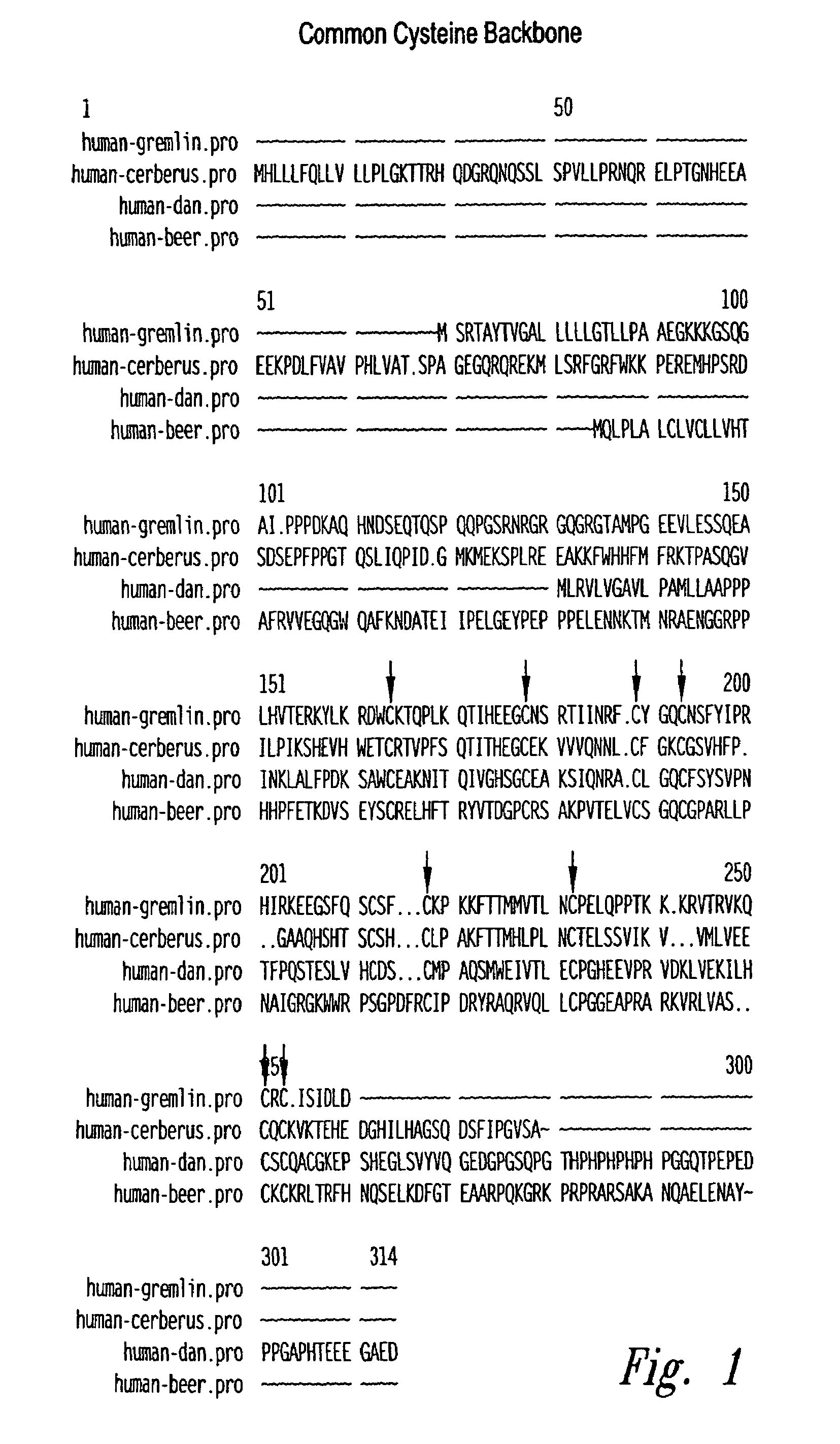Antibodies specific for sclerostin
a technology of sclerostin and antibodies, applied in antibody mimetics/scaffolds, virus, fusion polypeptides, etc., can solve the problems of tens of billions of dollars, osteoporosis is one of the most expensive diseases in the health care system, and significant medical problems, so as to and increase bone mineral content and bone mineral density.
- Summary
- Abstract
- Description
- Claims
- Application Information
AI Technical Summary
Benefits of technology
Problems solved by technology
Method used
Image
Examples
example 1
Sclerosteosis Maps to the Long Arm of Human Chromosome 17
[0285]Genetic mapping of the defect responsible for sclerosteosis in humans localized the gene responsible for this disorder to the region of human chromosome 17 that encodes a novel TGF-beta binding-protein family member. In sclerosteosis, skeletal bone displays a substantial increase in mineral density relative to that of unafflicted individuals. Bone in the head displays overgrowth as well. Sclerosteosis patients are generally healthy although they may exhibit variable degrees of syndactyly at birth and variable degrees of cranial compression and nerve compression in the skull.
[0286]Linkage analysis of the gene defect associated with sclerosteosis was conducted by applying the homozygosity mapping method to DNA samples collected from 24 South African Afrikaaner families in which the disease occurred. (Sheffield et al., 1994, Human Molecular Genetics 3:1331-1335. “Identification of a Bardet-Biedl syndrome locus on chromosome...
example 2
Tissue-Specificity of TGF-beta Binding-protein Gene Expression
A. Human Beer Gene Expression by RT-PCR:
[0289]First-strand cDNA was prepared from the following total RNA samples using a commercially available kit (“Superscript Preamplification System for First-Strand cDNA Synthesis”, Life Technologies, Rockville, Md.): human brain, human liver, human spleen, human thymus, human placenta, human skeletal muscle, human thyroid, human pituitary, human osteoblast (NHOst from Clonetics Corp., San Diego, Calif.), human osteosarcoma cell line (Saos-2, ATCC# HTB-85), human bone, human bone marrow, human cartilage, vervet monkey bone, saccharomyces cerevisiae, and human peripheral blood monocytes. All RNA samples were purchased from a commercial source (Clontech, Palo Alto, Calif.), except the following which were prepared in-house: human osteoblast, human osteosarcoma cell line, human bone, human cartilage and vervet monkey bone. These in-house RNA samples were prepared using a commercially av...
example 3
Expression and Purification of Recombinant Beer Protein
A. Expression in COS-1 Cells:
[0295]The DNA sequence encoding the full length human Beer protein was amplified using the following PCR oligonucleotide primers: The 5′ oligonucleotide primer had the sequence 5′-AAGCTTGGTACCATGCAGCTCCCAC-3′ (SEQ ID NO:23) and contained a HindIII restriction enzyme site (in bold) followed by 19 nucleotides of the Beer gene starting 6 base pairs prior to the presumed amino terminal start codon (ATG). The 3′ oligonucleotide primer had the sequence 5′-AAGCTTCTACTTGTCATCGTCGTCCT TGTAGTCGTAGGCGTTCTCCAGCT-3′ (SEQ ID NO:24) and contained a HindIII restriction enzyme site (in bold) followed by a reverse complement stop codon (CTA) followed by the reverse complement of the FLAG epitope (underlined, Sigma-Aldrich Co., St. Louis, Mo.) flanked by the reverse complement of nucleotides coding for the carboxy terminal 5 amino acids of the Beer. The PCR product was TA cloned (“Original TA Cloning Kit”, Invitrogen, ...
PUM
| Property | Measurement | Unit |
|---|---|---|
| dissociation constant | aaaaa | aaaaa |
| height | aaaaa | aaaaa |
| dissociation constant KD | aaaaa | aaaaa |
Abstract
Description
Claims
Application Information
 Login to View More
Login to View More - R&D
- Intellectual Property
- Life Sciences
- Materials
- Tech Scout
- Unparalleled Data Quality
- Higher Quality Content
- 60% Fewer Hallucinations
Browse by: Latest US Patents, China's latest patents, Technical Efficacy Thesaurus, Application Domain, Technology Topic, Popular Technical Reports.
© 2025 PatSnap. All rights reserved.Legal|Privacy policy|Modern Slavery Act Transparency Statement|Sitemap|About US| Contact US: help@patsnap.com



